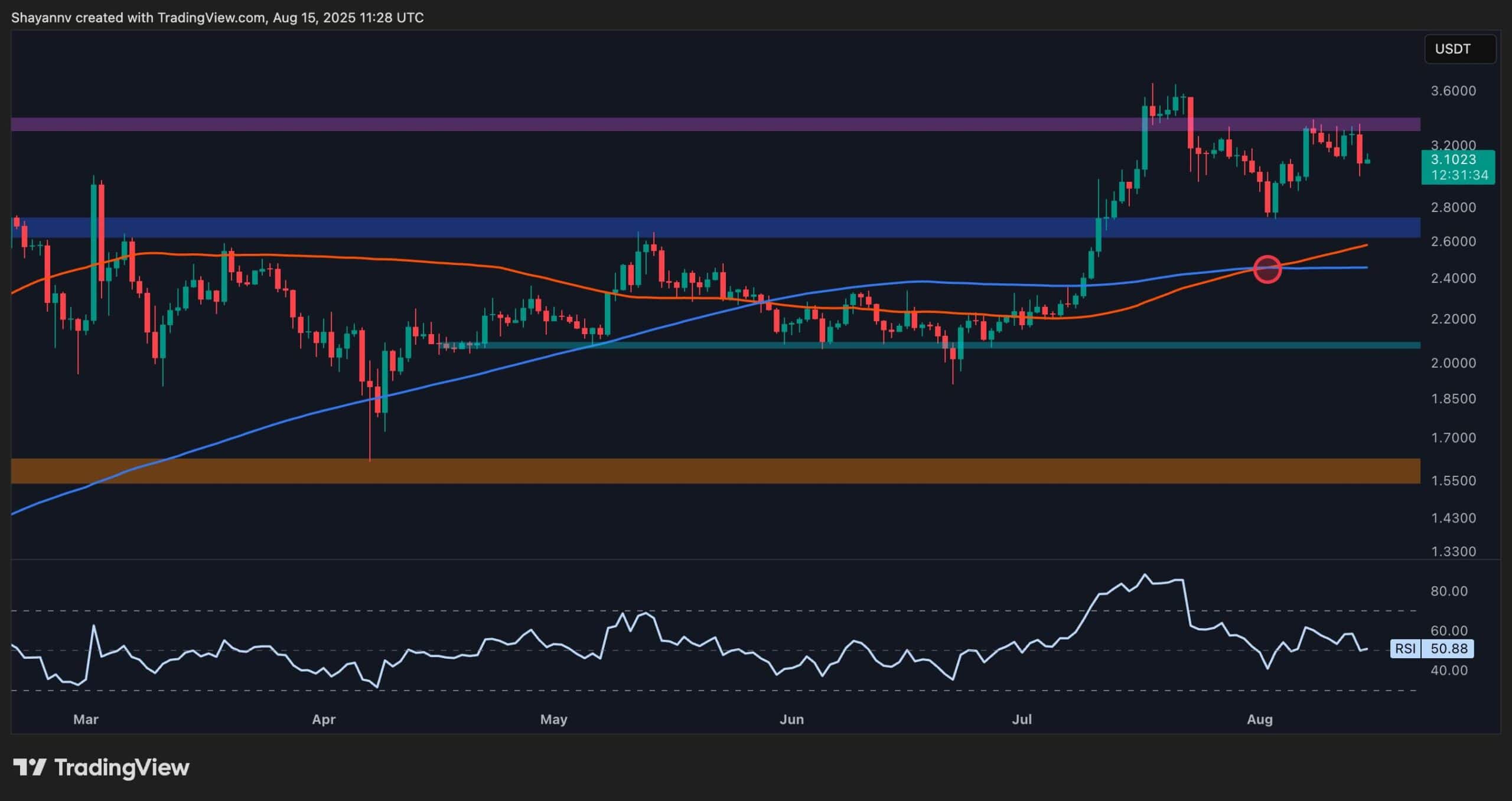Cryptocurrency
BEVM Unveils Groundbreaking Taproot Consensus for Decentralized Bitcoin Layer 2 Solution

[PRESS RELEASE – Cardiff, 英国, May 26th, 2024]
On May 20, 2024, the Bitcoin Layer2 development team BEVM released the technical yellow paper titled “Taproot Consensus: A Decentralized BTC Layer2 Solution.” This paper details the implementation of Taproot Consensus, leveraging native Bitcoin technologies such as Schnorr signatures, MAST, and Bitcoin SPV nodes to build a fully decentralized BTC Layer2 solution. Taproot Consensus represents a significant leap in native Bitcoin scalability, combining existing Bitcoin technologies innovatively without modifying Bitcoin’s core code.
I. History of Bitcoin’s Technical Iterations
- October 31, 2008: Satoshi Nakamoto published “Bitcoin: A Peer-to-Peer Electronic Cash System,” introducing Bitcoin and the concept of SPV (Simple Payment Verification).
- January 3, 2009: Nakamoto mined the Genesis Block, launching Bitcoin. The original code used ECDSA for digital signatures instead of the more suitable Schnorr signatures, which were under patent protection at the time. Schnorr signatures retain all the functionalities and security assumptions of ECDSA and can surpass the 15-signature limit of ECDSA, enabling the management of Bitcoin with thousands of addresses without affecting signing speed.
- 2018: Bitcoin core developers proposed integrating Schnorr signatures into the Bitcoin network.
- November 14, 2021: The Taproot upgrade integrated Schnorr signatures and introduced MAST (Merkelized Abstract Syntax Trees), enabling smart contract-like capabilities and decentralized multi-signature management.
- The Taproot Consensus solution by BEVM builds on these advancements, combining Schnorr signatures and MAST to manage multi-signature addresses and enable complex business scenarios in Bitcoin Layer2.
II. Overview of the Taproot Consensus Solution:
The yellow paper begins by highlighting Bitcoin’s non-Turing complete nature and limited functionality for smart contracts. It argues for using Bitcoin’s existing capabilities to build a decentralized Layer2 solution rather than modifying Bitcoin Layer1.
BEVM’s Taproot Consensus combines Bitcoin’s Taproot technology (Schnorr signatures and MAST), Bitcoin SPV light nodes, and the BFT PoS consensus mechanism to create a decentralized and consistent Layer2 network.
III. Detailed Explanation of Taproot Consensus Architecture
The Taproot Consensus architecture comprises three main components: Schnorr+MAST, Bitcoin SPV, and Aura+Grandpa.
· Schnorr+MAST: Uses these technologies from the Taproot upgrade to achieve decentralized Bitcoin multi-signature management driven by Bitcoin code.
· Bitcoin SPV: Allows synchronization and verification of Bitcoin transactions without running a full node.
· Aura + Grandpa: Advanced PoS consensus protocols for Byzantine fault tolerance, ensuring high consistency among network nodes.
In the BEVM system, each validator holds a BTC private key for Schnorr signatures. The aggregated public key forms a MAST tree, enabling BTC transfers and inscriptions to the threshold signature address. Validators act as Bitcoin SPV light nodes, synchronizing the BTC network state securely and permissionlessly. Aura+Grandpa ensures the Layer2 network’s security and trustworthiness, with assets managed by BFT consensus.
The operating principle of Taproot Consensus is: “In the BEVM system, each validator holds a BTC private key for Schnorr signatures. The characteristic of Schnorr signatures enables efficient signature aggregation, thereby enhancing the system’s security and efficiency. The aggregated public key Pagg, generated through the Musig2 multi-signature scheme, forms a large MAST (Merkle Abstract Syntax Tree). After generating the root hash of the MAST tree, validators perform BTC transfers and inscriptions to the threshold signature address generated by the MAST tree, enabling the submission of data from the BTC mainnet to the BEVM network. Each validator also acts as a Bitcoin SPV (Simplified Payment Verification) light node, allowing them to securely and permissionlessly synchronize the BTC network state.”
IV. Other Technical Details in the Yellow Paper – True Decentralization
The yellow paper also details the implementation of Schnorr signatures, MAST, Bitcoin SPV light nodes, and Aura+Grandpa, providing a comprehensive technical outline for those interested in Bitcoin technologies. It explains the Musig2 implementation and contrasts with other BTC Layer2 projects like Mezo, which uses the tBTC protocol. Unlike tBTC, which relies on a network of nine signatories, Taproot Consensus integrates multi-signature networks with BFT PoS consensus, achieving true decentralization.
Moreover, the yellow paper explains the implementation process of Musig2 and the differences between other BTC Layer2 projects like Mezo and Taproot Consensus. Mezo’s underlying technical structure is based on the tBTC protocol, which uses Bitcoin multi-signature to construct a threshold signature network, offering strong consistency compared to traditional distributed networks. However, tBTC still relies on a network of nine signatories, whereas a truly decentralized system should be consensus-driven, combining multi-signature networks with BFT PoS (Byzantine Fault Tolerance Proof of Stake) consensus mechanisms. This is the difference between distributed networks and blockchains; distributed networks emphasize distribution but lack Byzantine fault-tolerant consensus, whereas blockchains, while also being distributed networks, are driven by Byzantine fault-tolerant consensus, achieving true decentralization. The Taproot Consensus solution adopts this more advanced design. By integrating Schnorr signatures, MAST, Bitcoin SPV light nodes, and Aura and Grandpa Byzantine fault-tolerant consensus mechanisms, it constructs a highly consistent and secure decentralized Layer2 scalability solution. This integration enhances the scalability and usability of the Bitcoin network and ensures the security and consistency of the BEVM network.
Conclusion
The BEVM team’s technical yellow paper comprehensively describes Taproot Consensus, a Bitcoin Layer2 solution built entirely on native Bitcoin technologies. It respects and innovates on Bitcoin’s original technological direction, making it a true evolution of native Bitcoin scalability technology. As the Bitcoin ecosystem evolves, solutions like Taproot Consensus will be crucial for its development, serving as major cornerstones for truly decentralized Bitcoin Layer2 solutions.
About BEVM
BEVM is the first fully decentralized, EVM-compatible Bitcoin Layer 2 solution. It allows Ethereum ecosystem DApps to operate on Bitcoin, using BTC as gas. BEVM enhances Bitcoin’s utility by providing a secure and scalable platform for decentralized applications. The system integrates advanced consensus mechanisms, cross-chain interaction, and robust data integrity to ensure a seamless experience. BEVM aims to innovate within the Bitcoin ecosystem by offering increased scalability, security, and compatibility with popular Ethereum tools and applications.
For more information, users can visit BEVm’s official website or follow BEVM on Twitter.
Binance Free $600 (CryptoPotato Exclusive): Use this link to register a new account and receive $600 exclusive welcome offer on Binance (full details).
LIMITED OFFER 2024 at BYDFi Exchange: Up to $2,888 welcome reward, use this link to register and open a 100 USDT-M position for free!
Cryptocurrency
Ethereum Foundation, Whales, and Hackers: What’s Driving the ETH Sell-Off?

TL;DR
- Whales, hackers, and the Ethereum Foundation wallets moved over $500M in ETH through large sales and withdrawals.
- Ethereum transfers rose to 4.6M ETH, nearing the monthly high of 5.2M recorded in July.
- Staking inflows hit 247,900 ETH, the highest in a month, locking more supply from trading.
Large Withdrawals and Whale Activity
Ethereum (ETH) has seen heavy movement from major wallets over the past few days. On-chain data from Lookonchain shows a newly created wallet pulled 17,591 ETH, worth $81.62 million, from Kraken in just two hours.
Over three days, two new wallets withdrew a combined 71,025 ETH, valued at $330 million, from the exchange.
One of these wallets, address 0x2A92, has withdrawn 53,434 ETH, worth $242.34 million, in two days. This includes a recent purchase of 30,069 ETH, valued at $138.46 million, during a market drop.
Major ETH Holders Offload Millions Amid Price Rally
In contrast, several separate entities have been disposing of some ETH holdings. A wallet tied to a hacker address 0x17E0 sold 4,958 ETH for $22.13 million at $4,463, securing a profit of $9.75 million. Earlier this year, the same address sold 12,282 ETH at $1,932 and later bought back part of the amount at higher prices.
A different whale sold 20,600 ETH for $96.55 million over the past two days, generating a profit of more than $26 million after holding the position for nine months.
Meanwhile, an Ethereum Foundation-linked wallet, 0xF39d, sold 6,194 ETH worth $28.36 million in the last three days at an average price of $4,578.
Recent sales from the same wallet included an additional 1,100 ETH and 1,695 ETH for over $12.7 million combined.
The #EthereumFoundation-linked wallet(0xF39d) sold another 1,300 $ETH($5.87M) at $4,518 ~11 hours ago.
Over the past 3 days, this wallet has sold a total of 6,194 $ETH($28.36M) at an average price of $4,578.https://t.co/4hfCWymHVG pic.twitter.com/ErUyEY8SJy
— Lookonchain (@lookonchain) August 15, 2025
Network Activity on the Rise
CryptoQuant data shows Ethereum’s total tokens transferred have been climbing since August 9. After ranging between 1 million and 3 million ETH through late July and early August, transfers have risen to 4.6 million ETH, approaching the monthly high of 5.2 million recorded in mid-July. This increase has occurred alongside a price rally from about $3,400 to $4,600.
Interestingly, staking inflows generally stayed between 20,000 and 80,000 ETH per day over the past month. On August 14, inflows jumped to 247,900 ETH, the highest in the period.
At the time, ETH was trading near $4,600. Large staking deposits reduce the amount of ETH available for immediate trading, as staked coins are locked for a set period.
In the meantime, ETH trades at $4,647 with a 24-hour volume of $68.25 billion, down 2% on the day but up 19% over the week.
Binance Free $600 (CryptoPotato Exclusive): Use this link to register a new account and receive $600 exclusive welcome offer on Binance (full details).
LIMITED OFFER for CryptoPotato readers at Bybit: Use this link to register and open a $500 FREE position on any coin!
Cryptocurrency
Massive DOGE Whale Activity Hints at $1 Breakout

TL;DR
- Whales bought two billion DOGE this week, lifting their combined holdings to 27.6 billion coins.
- A single 900M DOGE transfer worth $208M to Binance drew attention to large exchange movements.
- DOGE broke key resistance, with momentum building for a possible push toward the $1 price mark.
Price and Market Moves
Dogecoin (DOGE) traded at $0.23 at press time, slipping 4% over the past day but still showing a 2% gain for the week. Daily turnover came in at about $6.18 billion.
Meanwhile, the broader crypto market saw over $1 billion in liquidations. Hotter-than-expected US Producer Price Index data pushed traders to scale back expectations of a near-term Federal Reserve rate cut. DOGE had roughly 290,500 coins liquidated during the sell-off.
On the two-week chart, analyst Trader Tardigrade notes that DOGE has cleared a downward-sloping resistance line after completing what appears to be a “wave V” in an Elliott Wave sequence. Similar setups in the past, where prolonged declines stayed within falling channels before breaking higher, have been followed by sharp rallies.
$Doge/2-week#Dogecoin is gaining strong momentum to surge above $1 pic.twitter.com/TuSEKr19nv
— Trader Tardigrade (@TATrader_Alan) August 15, 2025
Momentum gauges are also turning up. The Stochastic RSI, which had dropped into oversold territory, is now heading higher. Previous reversals from this zone have coincided with sustained upward moves. The current formation points to a possible run that could carry DOGE past the $1 mark.
Heavy Whale Buying and Large Transfers
As reported by CryptoPotato, blockchain data shows large investors have added two billion DOGE in the past week, spending just under $500 million. That brings their holdings to about 27.6 billion coins, or 18% of the supply. The buying streak has prompted speculation within the community.
Recently, Whale Alert flagged a 900 million DOGE transfer worth about $208 million into Binance. The tracking indicates that it originated from a wallet connected to the exchange, likely as an internal activity. The address involved holds 2.88 billion DOGE, one of the largest balances on the network.
Ali Martinez also reports that transactions above $1 million reached a one-month high, with activity building since early August and peaking as DOGE traded at $0.25.
Whales are back! Dogecoin $DOGE activity at a 1-month high. pic.twitter.com/C83Pv68mCt
— Ali (@ali_charts) August 14, 2025
Sentiment Building
Analyst Gordon described the current setup as “a nice bit of consolidation” before a potential breakout, adding,
“This will be one of the first coins normies FLOCK to & the pump will be MASSIVE.”
With whale accumulation rising, high-value transfers increasing, and a bullish technical pattern in play, DOGE is positioned for a potential push toward $1 if momentum holds.
Binance Free $600 (CryptoPotato Exclusive): Use this link to register a new account and receive $600 exclusive welcome offer on Binance (full details).
LIMITED OFFER for CryptoPotato readers at Bybit: Use this link to register and open a $500 FREE position on any coin!
Cryptocurrency
Ripple Price Analysis: XRP at Risk as Key Support Levels Could Trigger Sharp Drop

XRP has recently entered a consolidation phase after a strong rally earlier this summer, with the price action now hovering around key resistance levels on both its USDT and BTC pairs. Yet, while momentum has slowed, the charts still indicate a generally bullish structure, with multiple key support levels remaining firmly in place.
Technical Analysis
By ShayanMarkets
The USDT Pair
On the XRP/USDT daily chart, the price is currently trading near the $3.10 mark, facing a strong resistance zone around $3.40. This follows a breakout above the $2.70 range in July, which has now flipped into a support area.
Both the 100-day and 200-day moving averages are also trending upward and recently formed a bullish crossover around $2.45, reinforcing the medium-term bullish sentiment. If the $3.40 resistance breaks, a push toward the critical $4.00 range becomes likely.
However, the RSI hovering near the neutral 50 level suggests a lack of strong momentum for now, meaning a short-term pullback into the $2.80 support zone is still possible.
This zone will be key for maintaining the bullish structure. Losing it could open the door for a deeper correction toward the 200-day moving average located around the $2.40 mark. Yet, as long as the price stays above the moving averages, the broader trend remains bullish.
The BTC Pair
Looking at the XRP/BTC chart, the pair has recently pulled back after hitting the 3,000 SAT resistance, with the price currently around 2,600 SAT.
This follows a clean breakout above the long-term descending channel and a successful retest of its upper boundary, which coincided with the 200-day moving average and the 2,400 SAT support zone. This confluence remains a key bullish technical factor, as holding above it could attract renewed buying pressure.
That said, RSI levels around 48 show that momentum has cooled after the sharp July rally, meaning XRP may continue ranging between 2,400 SAT and 3,000 SAT in the near term. A decisive close above 3,000 SAT would likely open the path to the 3,400 SAT zone, while losing 2,400 SAT could shift the bias back toward 2,000 SAT support. For now, the structure still favors the bulls as long as higher lows remain intact.
Binance Free $600 (CryptoPotato Exclusive): Use this link to register a new account and receive $600 exclusive welcome offer on Binance (full details).
LIMITED OFFER for CryptoPotato readers at Bybit: Use this link to register and open a $500 FREE position on any coin!
Disclaimer: Information found on CryptoPotato is those of writers quoted. It does not represent the opinions of CryptoPotato on whether to buy, sell, or hold any investments. You are advised to conduct your own research before making any investment decisions. Use provided information at your own risk. See Disclaimer for more information.
Cryptocurrency charts by TradingView.

 Forex3 years ago
Forex3 years agoForex Today: the dollar is gaining strength amid gloomy sentiment at the start of the Fed’s week

 Forex3 years ago
Forex3 years agoUnbiased review of Pocket Option broker

 Forex3 years ago
Forex3 years agoDollar to pound sterling exchange rate today: Pound plummeted to its lowest since 1985

 Forex3 years ago
Forex3 years agoHow is the Australian dollar doing today?

 Cryptocurrency3 years ago
Cryptocurrency3 years agoWhat happened in the crypto market – current events today

 World3 years ago
World3 years agoWhy are modern video games an art form?

 Commodities3 years ago
Commodities3 years agoCopper continues to fall in price on expectations of lower demand in China

 Economy3 years ago
Economy3 years agoCrude oil tankers double in price due to EU anti-Russian sanctions























